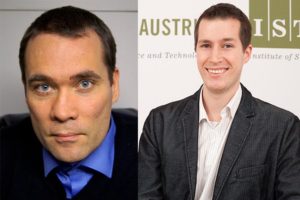December 15, 2015
Tamás Hausel new Professor and Chris Wojtan promoted to Professor
IST Austria professors in mathematics and in computer science in 2016

President Thomas Henzinger announced the appointment of IST Austria’s 40th member of its faculty and a promotion to Professor. The Hungarian mathematician Tamás Hausel will join IST Austria as Professor from the École Polytechnique Fédérale de Lausanne (EPFL) in 2016, and computer scientist Chris Wojtan has been promoted to Professor after his successful tenure evaluation.
Henzinger stated: “Tamás Hausel is a major gain for IST Austria and his appointment demonstrates the Institute’s attractiveness for excellence. And I congratulate Chris Wojtan on his promotion. IST Austria offers a tenure-track model for scientists with an obligatory evaluation by an international peer review panel.”
The research interests of mathematician Tamás Hausel include combinatorial, differential, and algebraic geometry and topology. Hausel’s main tool is representation theory which studies algebraic structures (such as groups, rings, fields, but also vector spaces and modules) by representing their elements as matrices, thus rendering abstract algebraic objects more concrete. The more specific focus of Hausel’s work is the geometry, topology and arithmetic of several moduli spaces, i.e. spaces whose points represent solutions or parameters to geometric classification problems. Hausel applies these studies to number theory as well as to theoretical physics where he addresses mathematical problems arising in string theory and topological quantum field theory.
After his studies at Eötvös Lórand University in Budapest, Tamás Hausel obtained a certificate of Advanced Mathematics with Distinction at University of Cambridge, where he also received his PhD in Pure Mathematics in 1998 at Trinity College. He consequently became a member of the Institute for Advanced Study in Princeton and a Miller Research Fellow of the Miller Institute for Basic Research in Science at University of California in Berkeley. From 2002–2010, Hausel worked as Assistant and Associate Professor at the Department of Mathematics at the University of Texas in Austin. In addition, he joined the Mathematical Institute at University of Oxford as University Lecturer in Pure Mathematics (2007–2012), and became a Tutorial Fellow in Wadham College, Oxford (2007–2012) and a Royal Society University Research Fellow at the Mathematical Institute of University of Oxford (2005–2012). Since 2012, Tamás Hausel is Full Professor and director of the Chair of Geometry at EPFL in Lausanne, and he will join IST Austria in fall 2016. Hausel was awarded in 2013 with an ERC Advanced Grant for his work on “Arithmetic and physics of Higgs moduli spaces”.
Computer scientist Chris Wojtan has been promoted to Professor after his successful tenure evaluation. The career model of IST Austria is based on a tenure-track system with a compulsory evaluation. Wojtan’s research focuses on the realistic simulation of complex phenomena in the physical world such as fluids or deformable bodies. He combines mathematical methods from computational physics with geometric techniques from computer graphics. One of his key contributions is the efficient treatment of topological changes with deforming meshes that split and merge in order to simulate highly detailed surface tension phenomena such as the formation of water droplets and splashes. Accurate representations of physical processes of that kind are not only required for computer animation but also for medical simulations, computational physics, and digital modeling.
The US American Wojtan received his PhD in computer science from Georgia Institute of Technology for which he also got The Sigma Xi Best PhD Thesis Award in 2011. He was a recipient of the James Scholarship in 2003, of the Presidential Fellowship in 2004, and the National Science Foundation Graduate Research Fellowship in 2005–2008. Wojtan joined IST Austria in 2011 as Assistant Professor and will be the faculty’s youngest Professor. Since then, he received the Microsoft Visual Computing Award (2013), an ERC Starting Grant for his project “Big Splash: Efficient Simulation of Natural Phenomena at Extremely Large Scales” (2014), the Eurographics Young Researcher Award in (2015), and the Günter Enderle Best Paper Award from Eurographics (2015).



